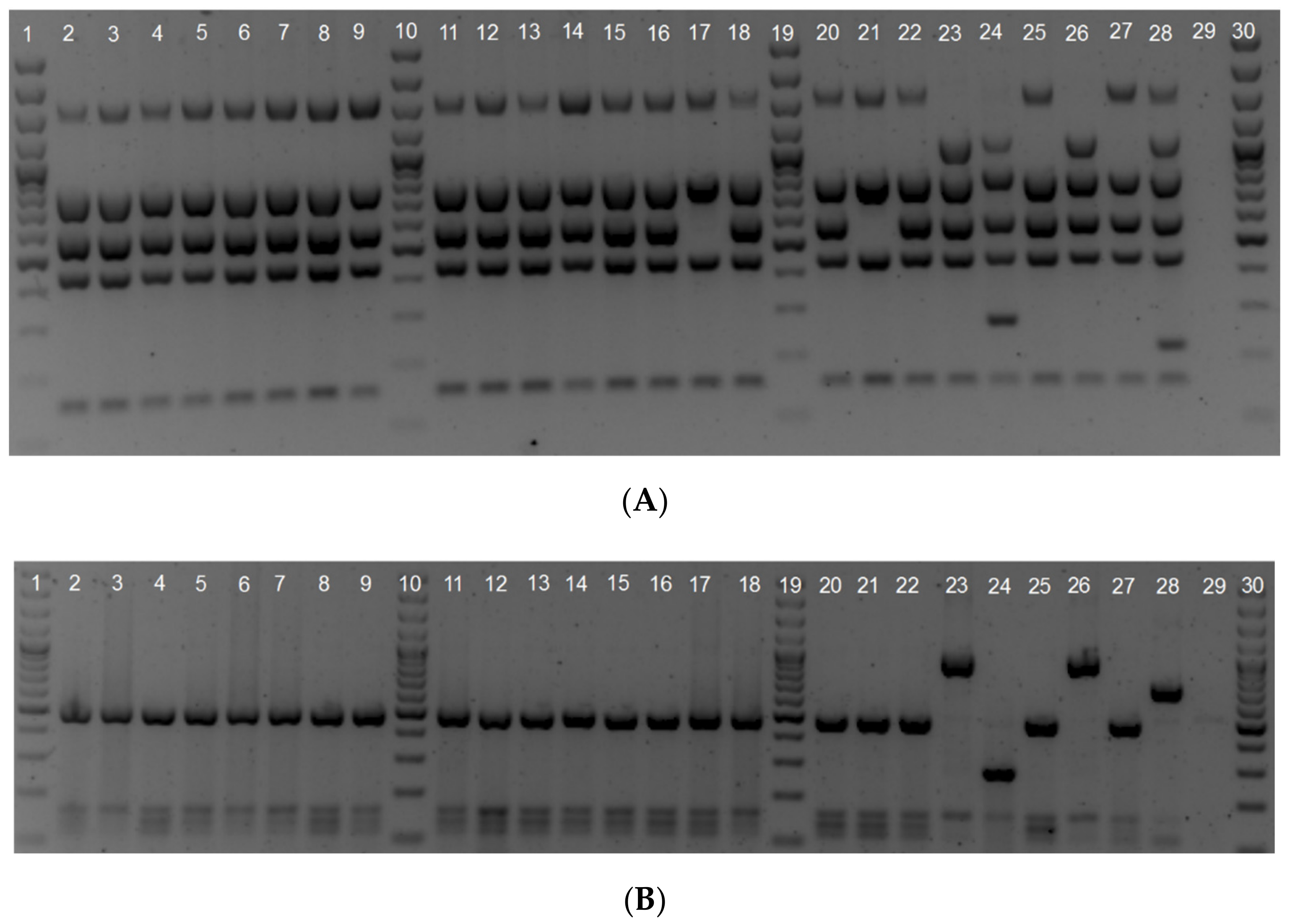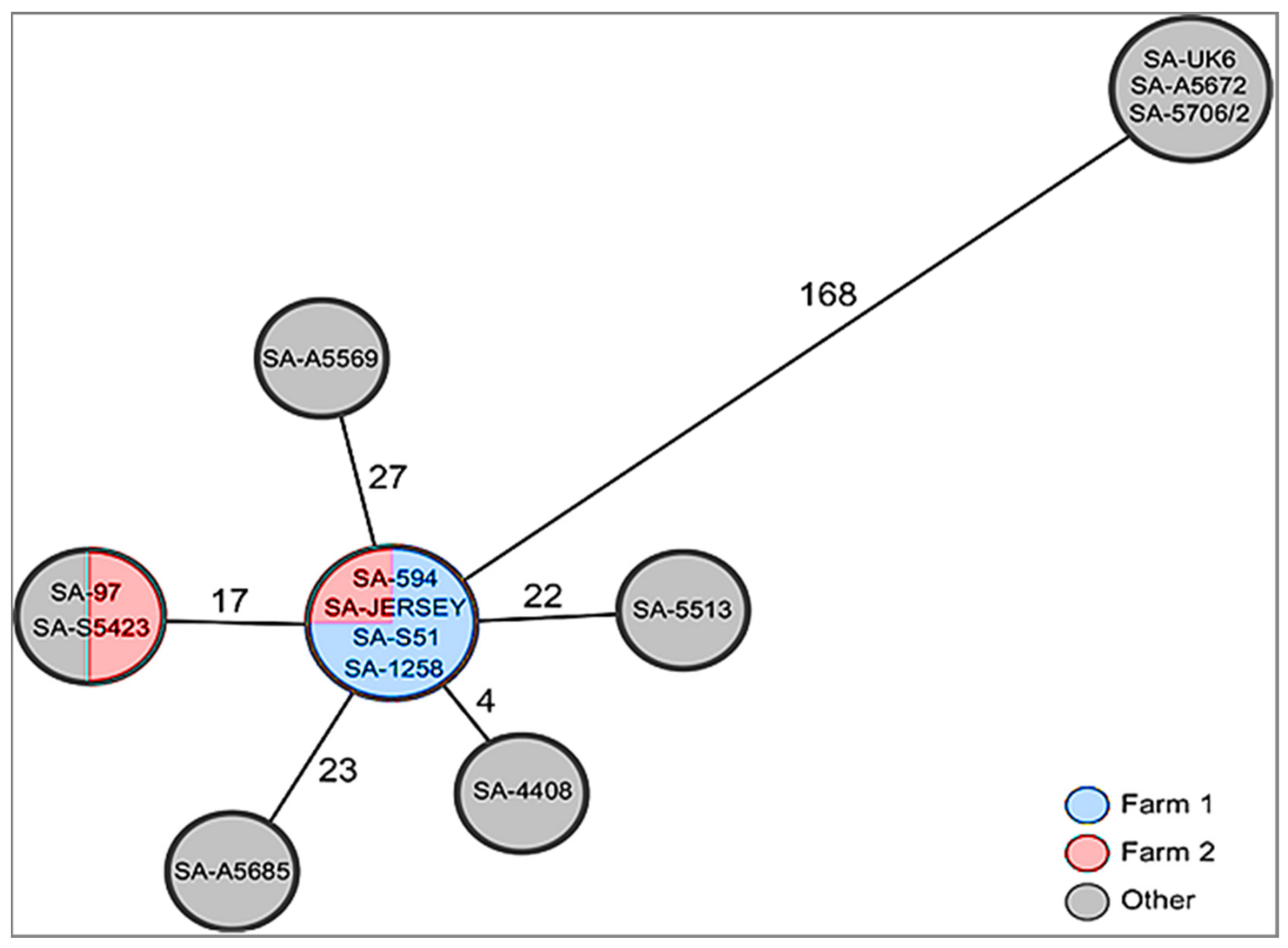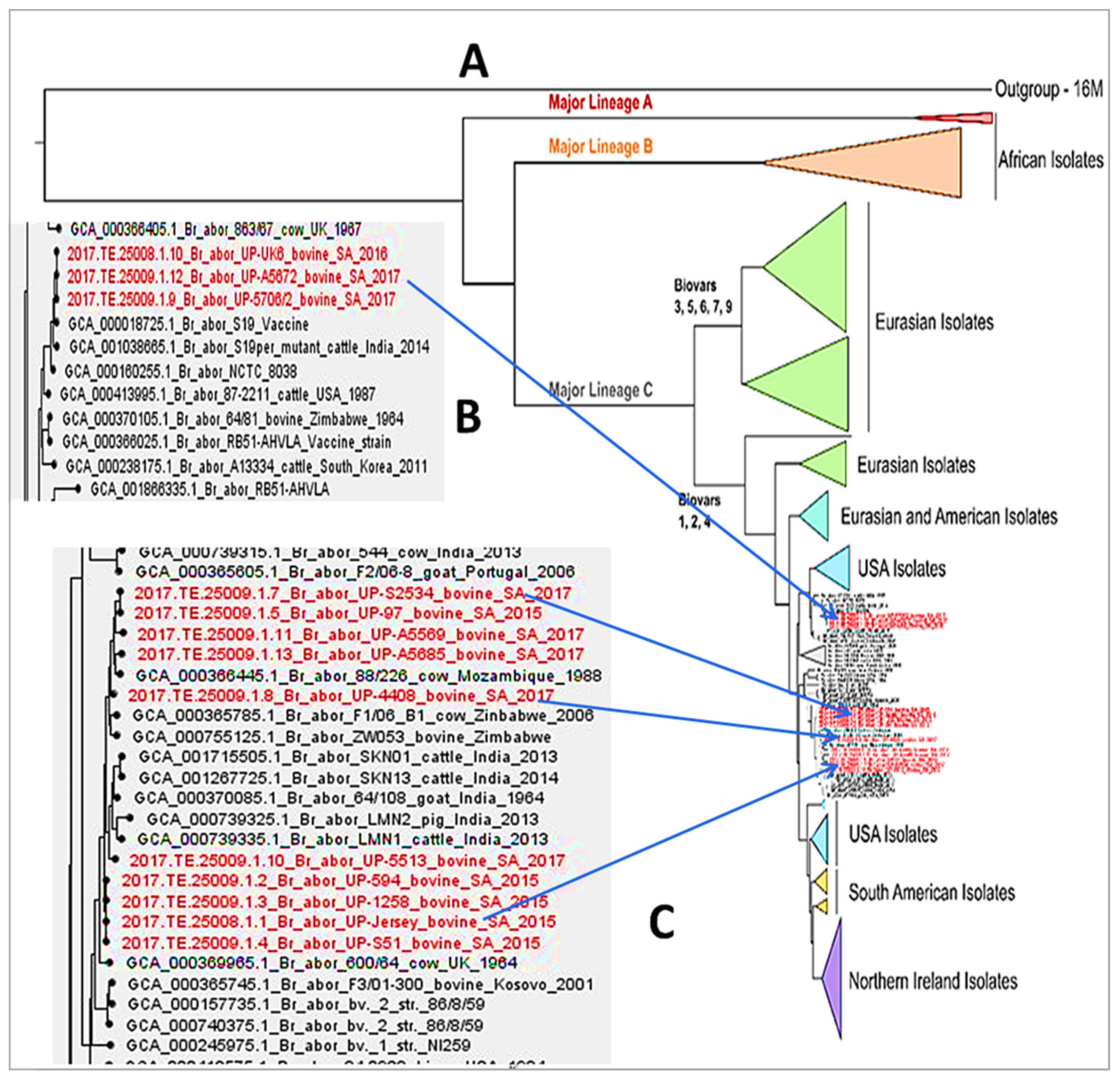Whole Genome Sequence Analysis of Brucella abortus Isolates from Various Regions of South Africa
Abstract
1. Introduction
2. Materials and Methods
2.1. Samples and Sample Area
2.2. Bacterial Strains, DNA Extraction, Quantification, and Molecular Identification
2.3. Whole-Genome Sequencing
2.4. WGS-SNP Data Analysis
3. Results and Discussion
Supplementary Materials
Author Contributions
Funding
Institutional Review Board Statement
Informed Consent Statement
Data Availability Statement
Acknowledgments
Conflicts of Interest
References
- List of Prokaryotic Names with Standing in Nomenclature (LPSN). Species. Available online: http://www.bacterio.net/-allnamesac.html (accessed on 1 August 2018).
- De, B.K.; Stauffer, L.; Koylass, M.S.; Sharp, S.E.; Gee, J.E.; Helsel, L.O.; Steigerwalt, A.G.; Vega, R.; Clark, T.A.; Daneshvar, M.I.; et al. Novel Brucella strain (BO1) associated with a prosthetic breast implant infection. J. Clin. Microbiol. 2008, 46, 43–49. [Google Scholar] [CrossRef][Green Version]
- Scholz, H.C.; Nöckler, K.; Göllner, C.; Bahn, P.; Vergnaud, G.; Tomaso, H.; Al Dahouk, S.; Kämpfer, P.; Cloeckaert, A.; Maquart, M.; et al. Brucella inopinata sp. nov., isolated from a breast implant infection. Int. J. Syst. Evol. Microbiol. 2010, 60, 801–808. [Google Scholar] [CrossRef] [PubMed]
- Scholz, H.C.; Revilla-Fernandez, S.; Al Dahouk, S.; Hammerl, J.A.; Zygmunt, M.S.; Cloeckaert, A.; Koylass, M.; Whatmore, A.M.; Blom, J.; Vergnaud, G.; et al. Brucella vulpis sp. nov., isolated from mandibular lymph nodes of red foxes (Vulpes vulpes). Int. J. Syst. Evol. Microbiol. 2016, 66, 2090–2098. [Google Scholar] [CrossRef] [PubMed]
- Soler-Lloréns, P.F.; Quance, C.R.; Lawhon, S.D.; Stuber, T.P.; Edwards, J.F.; Ficht, T.A.; Robbe-Austerman, S.; O’Callaghan, D.; Keriel, A. A Brucella spp. isolate from a Pac-Man frog (Ceratophrys ornata) reveals characteristics departing from classical Brucellae. Front. Cell. Infect. Microbiol. 2016, 6, 116. [Google Scholar] [CrossRef]
- Al Dahouk, S.; Köhler, S.; Occhialini, A.; Jiménez de Bagüés, M.P.; Hammer, J.A.; Eisenberg, T.; Vergnaud, G.; Cloeckaert, A.; Zygmunt, M.S.; Whatmore, A.M.; et al. Brucella spp. of amphibians comprise genomically diverse motile strains competent for replication in macrophages and survival in mammalian hosts. Sci. Rep. 2017, 7, 44420. [Google Scholar] [CrossRef] [PubMed]
- Eisenberg, T.; Riße, K.; Schauerte, N.; Geiger, C.; Blom, J.; Scholz, H.C. Isolation of a novel ‘atypical’ Brucella strain from a bluespotted ribbontail ray (Taeniura lymma). Antonie Leeuwenhoek 2017, 110, 221–234. [Google Scholar] [CrossRef]
- Mühldorfer, K.; Wibbelt, G.; Szentiks, C.A.; Fischer, D.; Scholz, H.C.; Zschöck, M.; Eisenberg, T. The role of ‘atypical’ Brucella in amphibians: Are we facing novel emerging pathogens? J. Appl. Microbiol. 2016, 122, 40–53. [Google Scholar] [CrossRef]
- Pappas, G.; Papadimitriou, P.; Akritidis, N.; Christou, L.; Tsianos, E.V. The new global map of human brucellosis. Lancet Infect. Dis. 2006, 6, 91–99. [Google Scholar] [CrossRef]
- McDermott, J.J.; Grace, D.; Zinsstag, J. Economics of brucellosis impact and control in low-income countries. Rev. Sci. Tech. Off. Int. Epiz. 2013, 32, 249–261. [Google Scholar] [CrossRef]
- Spickler, A.R. Brucellosis: Brucella abortus. 2018. Available online: http://www.cfsph.iastate.edu/DiseaseInfo/factsheets.php (accessed on 1 January 2019).
- Samaha, H.; Al-Rowaily, M.; Khoudair, R.M.; Ashour, H.M. Multicenter study of brucellosis in Egypt. Emerg. Infect. Dis. 2008, 14, 1916–1918. [Google Scholar] [CrossRef] [PubMed]
- Alvarez, J.; Suaez, J.L.; Garcia, N.; Serrat, C.; Perez-Sancho, M.; Gonzalez, S.; Ortega, M.J.; Gou, J.; Carbajo, L.; Garrido, F.; et al. Management of an outbreak of brucellosis due to B. melitensis in dairy cattle in Spain. Res. Vet. Sci. 2011, 90, 208–211. [Google Scholar]
- Ledwaba, B.; Mafofo, J.; van Heerden, H. Genome sequences of Brucella abortus and Brucella suis strains isolated from bovine in Zimbabwe. Genome Announc. 2014, 2, e01063-14. [Google Scholar] [CrossRef] [PubMed]
- Godfroid, J.; Al Dahouk, S.; Pappas, G.; Roth, F.; Matope, G.; Muma, J.; Marcotty, T.; Pfeiffer, D.; Skjerve, E. A “One Health” surveillance and control of brucellosis in developing countries: Moving away from improvisation. Comp. Immunol. Microbiol. Infect. Dis. 2013, 36, 241–248. [Google Scholar] [CrossRef] [PubMed]
- Bricker, B.J.; Halling, S.M. Differentiation of Brucella abortus bv. 1, 2, and 4, Brucella melitensis, Brucella ovis and Brucella suis bv. 1 by PCR. J. Clin. Microbiol. 1994, 32, 2660–2666. [Google Scholar] [CrossRef]
- Bricker, B.J.; Halling, S.M. Enhancement of the Brucella AMOS PCR assay for differentiation of Brucella abortus vaccine strains S19 and RB51. J. Clin. Microbiol. 1995, 33, 1640–1642. [Google Scholar] [CrossRef] [PubMed]
- Garcia-Yoldi, D.; Marin, C.M.; de Miguel, M.J.; Munoz, P.M.; Vizmanos, J.L.; Lopez-Goni, I. Multiplex PCR assay for the identification and differentiation of all Brucella species and the vaccine strains Brucella abortus S19 and RB51 and B. melitensis Rev1. Clin. Chem. 2006, 52, 779–781. [Google Scholar] [CrossRef][Green Version]
- Le Flèche, P.; Jacques, I.; Grayon, M.; Al Dahouk, S.; Bouchon, P.; Denoeud, F.; Nöckler, K.; Neubauer, H.; Guilloteau, L.A.; Vergnaud, G. Evaluation and selection of tandem repeat loci for a Brucella MLVA typing assay. BMC Microbiol. 2006, 6, 9. [Google Scholar] [CrossRef]
- Al Dahouk, S.; Le Fleche, P.; Nockler, K.; Jacques, I.; Grayon, M.; Scholz, H.C.; Tomaso, H.; Vergnaud, G.; Neubauer, H. Evaluation of Brucella MLVA typing for human brucellosis. J. Microbiol. Methods 2007, 69, 137–145. [Google Scholar] [CrossRef]
- Probert, W.S.; Schrader, K.N.; Khuong, N.Y.; Bystrom, S.L.; Graves, M.H. Real-Time multiplex PCR assay for detection of Brucella spp., B. abortus, and B. melitensis. J. Clin. Microbiol. 2004, 42, 1290–1293. [Google Scholar] [CrossRef] [PubMed]
- DAFF—Department of Agriculture, Forestry and Fisheries. Policy Discussion Paper on the Review of Bovine Brucellosis Control. 2017. Available online: http://www.daff.gov.za/vetweb/pamphlets&Information/Policy/Discussion%20paper%20on%20the%20review%20of%20bovine%20brucellosis%20control_Final%2005052017.pdf (accessed on 1 August 2018).
- Bishop, G.C.; Bosman, P.P.; Herr, S. Bovine Brucellosis. In Infectious Diseases of Livestock with Special Reference to Southern Africa; Coetzer, J.A.W., Thomson, G.R., Tustin, R.C., Eds.; Oxford University Press: Cape Town, South Africa, 1994; Volume 3, pp. 1510–1527. [Google Scholar]
- South African Veterinary Council. Annual Report Financial Statements April 2015–231 March 2016. Available online: https://static.pmg.org.za/SAVC_Annual_Report_2015-2016.pdf (accessed on 1 August 2018).
- Paulsen, I.T.; Seshadri, R.; Nelson, K.E.; Eisen, J.A.; Heidelberg, J.F.; Read, T.D.; Dodson, R.J.; Umayam, L.; Brinkac, L.M.; Beanan, M.J.; et al. The Brucella suis genome reveals fundamental similarities between animal and plant pathogens and symbionts. Proc. Natl. Acad. Sci. USA 2002, 99, 13148–13153. [Google Scholar] [CrossRef]
- Foster, J.T.; Beckstrom-Sternberg, S.M.; Pearson, T.; Beckstrom-Sternberg, J.S.; Chain, P.S.; Roberto, F.F.; Hnath, J.; Brettin, T.; Keim, P. Whole-genome-based phylogeny and divergence of the genus Brucella. J. Bacteriol. 2009, 191, 2864–2870. [Google Scholar] [CrossRef]
- Garofolo, G.; Di Giannatale, E.; Platone, I.; Zilli, K.; Sacchini, L.; Abass, A.; Ancora, M.; Cammà, C.; Di Donato, G.; De Massis, F.; et al. Origins and global context of Brucella abortus in Italy. BMC Microbiol. 2017, 17, 28. [Google Scholar] [CrossRef]
- Foster, J.T.; Price, L.B.; Beckstrom-Sternberg, S.M.; Pearson, T.; Brown, W.D.; Kiesling, D.M.; Allen, C.A.; Liu, C.M.; Beckstrom-Sternberg, J.; Roberto, F.F.; et al. Genotyping of Brucella species using clade specific SNPs. BMC Microbiol. 2012, 12, 110. [Google Scholar] [CrossRef]
- Moore, J.H. Bioinformatics. J. Cell. Physiol. 2007, 213, 365–369. [Google Scholar] [CrossRef]
- Mariano, D.C.B.; Leite, C.; Santos, L.H.S.; Rocha, R.E.O.; de Melo-Minardi, R.C. A guide to performing systematic literature reviews in bioinformatics. arXiv 2007. Available online: https://arxiv.org/pdf/1707 (accessed on 1 February 2019).
- Van der Auwera, G.A.; Carneiro, M.O.; Hartl, C.; Poplin, R.; Angel, G.D.; Levy-Moonshine, A.; Jordan, T.; Shakir, K.; Roazen, D.; Thibault, J.; et al. From FastQ Data to High-Confidence Variant Calls: The Genome Analysis Toolkit Best Practices Pipeline. Curr. Protoc. Bioinform. 2013, 43, 11.10.1–11.10.33. [Google Scholar]
- Janowicz, A.; De Massis, F.; Ancora, M.; Cammà, C.; Patavino, C.; Battisti, A.; Prior, K.; Harmsen, D.; Holger Scholz, H.; Zilli, K.; et al. Core genome multi locus sequence typing and single nucleotide polymorphism analyses in the epidemiology of Brucella melitensis infections. J. Clin. Microbiol. 2018. [Google Scholar] [CrossRef] [PubMed]
- Pightling, A.W.; Petronella, N.; Pagotto, F. Choice of reference sequence and assembler for alignment of Listeria monocytogenes short-read sequence data greatly influences rates of error in SNP Analyses. PLoS ONE. 2014, 9, e104579. [Google Scholar] [CrossRef] [PubMed]
- Georgi, E.; Walter, M.C.; Pfalzgraf, M.T.; Northoff, B.H.; Holdt, L.M.; Scholz, H.C.; Zoeller, L.; Zange, S.; Antwerpen, M.H. Whole genome sequencing of Brucella melitensis isolated from 57 patients in Germany reveals high diversity in strains from Middle East. PLoS ONE. 2017, 12, e0175425. [Google Scholar] [CrossRef] [PubMed]
- Ledwaba, M.B.; Ndumnego, O.C.; Matle, I.; Gelaw, A.K.; van Heerden, H. Investigating selective media for optimal isolation of Brucella spp. in South Africa. Onderstepoort J. Vet. Res. 2020, 87, 1–9. [Google Scholar] [CrossRef]
- World Organisation for Animal Health (OIE). Brucellosis (Infections with B. abortus, B. melitensis and B. suis). Manual of Diagnostic Tests and Vaccines for Terrestrial Animals; World Health Organization: Paris, France, 2016. Chapter 2.1.4. Available online: https://www.oie.int (accessed on 1 May 2018).
- Keid, L.B.; Soares, R.M.; Vasconcellos, S.A.; Chiebao, D.P. A polymerase chain reaction for detection of Brucella canis in vaginal swabs of naturally infected bitches. Theriogenology 2007, 68, 1260–1270. [Google Scholar] [CrossRef]
- Wood, D.E.; Salzberg, S.L. Kraken: Ultrafast metagenomic sequence classification using exact alignments. Genome Biol. 2014, 15, R46. [Google Scholar] [CrossRef] [PubMed]
- Sahl, J.W.; Beckstrom-Sternberg, S.M.; Babic-Sternberg., J.S.; Gillece., J.D.; Hepp, C.M.; Auerbach, R.K.; Tembe, W.; Wagner, D.M.; Keim, P.S.; Pearson, T. The In Silico Genotyper (ISG): An open-source pipeline to rapidly identify and annotate nucleotide variants for comparative genomics applications. bioRxiv 2015. [Google Scholar] [CrossRef]
- Li, H. Aligning sequence reads, clone sequences, and assembly contigs with BWA-MEM. arXiv 2013, arXiv:13033997. [Google Scholar]
- McKenna, A.; Hanna, M.; Banks, E.; Sivachenko, A.; Cibulskis, K.; Kernytsky, A.; Garimella, K.; Altshuler, D.; Gabriel, S.; Daly, M.; et al. The Genome Analysis Toolkit: A MapReduce framework for analyzing next-generation DNA sequencing data. Genome Res. 2010, 20, 1297–1303. [Google Scholar] [CrossRef]
- Gen Bank. Available online: https://www.ncbi.nlm.nih.gov/genbank/ (accessed on 1 August 2018).
- Nascimento, M.; Sousa, A.; Ramirez, M.; Francisco, A.P.; Carrico, J.A.; Vaz, C. PHYLOViZ 2.0: Providing scalable data integration and visualization for multiple phylogenetic inference methods. Bioinformatics 2017, 33, 128–129. [Google Scholar] [CrossRef]
- Swofford, D.L. PAUP* Phylogenetic Analysis Using Parsimony (*and Other Methods); Sinauer Associates: Sunderland, MA, USA, 2002. [Google Scholar]
- Matope, G.; Bhebhe, E.; Muma, J.B.; Skjerve, E.; Djonne, B. Characterization of some Brucella species from Zimbabwe by biochemical profiling and AMOS-PCR. BMC Res. Notes 2009, 2, 261–267. [Google Scholar] [CrossRef] [PubMed]
- Khames, M.; Mick, V.; de Miguel, M.J.; Girault, G.; Conde-Álvarez, R.; Khelef, D.; Oumouna, M.; Moriyόn, I.; Muñoz, P.M.; Zúniga-Ripa, A. The characterization of Brucella strains isolated from cattle in Algeria reveals the existence of a B. abortus lineage distinct from European and Sub-Saharan African strains. Vet. Microbiol. 2017, 211, 124–128. [Google Scholar] [CrossRef] [PubMed]
- Whatmore, A.M.; Koylass, M.S.; Muchowski, J.; Edwards-Smallbone, J.; Gopaul, K.K.; Perrett, L.L. Extended Multilocus Sequence Analysis to Describe the Global Population Structure of the Genus Brucella: Phylogeography and Relationship to Biovars. Front. Microbiol. 2017, 7, 2049. [Google Scholar] [CrossRef]
- Bertu, W.J.; Ducrotoy, M.J.; Munoz, P.M.; Mick, V.; Zúniga-Ripa, A.; Bryssinckx, W.; Kwaga, J.K.; Kabir, J.; Welburn, S.C.; Moriyón, I.; et al. Phenotypic and genotypic characterization of Brucella strains isolated from autochthonous livestock reveals the dominance of B. abortus biovar 3a in Nigeria. Vet. Microbiol. 2015, 180, 103–108. [Google Scholar] [CrossRef] [PubMed]
- Ducrotoy, M.; Bertu, W.J.; Matope, G.; Cadmus, S.; Conde-Álvarez, R.; Gusi, A.M.; Welburn, S.; Ocholi, R.; Blasco, J.M.; Moriyón, I. Brucellosis in Sub-Saharan Africa: Current challenges for management, diagnosis and control. Acta Trop. 2017, 165, 179–193. [Google Scholar] [CrossRef]
- Nicoletti, P. Vaccination against Brucella. Adv. Biotevhnol. Process. 1990, 13, 147–168. [Google Scholar]
- Schurig, G.G.; Sriranganathan, N.; Corbel, M.J. Brucellosis vaccines: Past, present and future. Vet. Microbiol. 2002, 90, 479–496. [Google Scholar] [CrossRef]
- Ferreira, A.C.; Chambel, L.; Tenreiro, T.; Cardoso, R.; Flor, L.; Dias, I.T.; Pacheco, T.; Garin-Bastuji, B.; Le Flèche, P.; Vergnaud, G.; et al. MLVA16 typing of Portuguese human and animal Brucella melitensis and Brucella abortus Isolates. PLoS ONE 2012, 7, e42514. [Google Scholar] [CrossRef] [PubMed]
- Simpson, G.J.G.; Marcotty, T.; Rouille, E.; Chilundo, A.; Letteson, J.J.; Godfroid, J. Immunological response to Brucella abortus strain 19 vaccination of cattle in a communal area in South Africa. J. S. Afr. Vet. Assoc. 2018, 89, e1–e7. [Google Scholar] [CrossRef] [PubMed]
- Olsen, S.C.; Stoffregen, W.S. Essential role of vaccines in brucellosis control and eradication programs for livestock. Expert Rev. Vaccines 2005, 4, 915–928. [Google Scholar] [CrossRef]
- Diaz, R.; Jones, L.M.; Leons, D.; Wilson, J.B. Surface antigens of smooth brucellae. J. Bacteriol. 1968, 96, 893–901. [Google Scholar] [CrossRef]
- Tabynov, K.; Raskolnikov, S.; Kydyrbayev, Z.; Sansyzbay, A. Safety of the novel influenza viral vector Brucella abortus vaccine in pregnant heifers. Ciênc. Rural 2016, 46, 114–118. [Google Scholar] [CrossRef]
- Nicoletti, P. Vaccination of cattle with Brucella abortus strain 19 administered by differing routes and doses. Vaccine 1984, 2, 133–135. [Google Scholar] [CrossRef]
- Poester, F.P.; Ramos, E.T.; Gomes, M.J.P.; Chiminazzo, C.; Schurig, G. The serological response of adult cattle after vaccination with Brucella abortus strain 19 and RB51. Braz. J. Vet. Res. Anim. Sci. 2000, 37. [Google Scholar] [CrossRef]
- Dean, A.S.; Crump, L.; Greter, H.; Schelling, E.; Zinsstag, J. Global burden of human brucellosis: A systematic review of disease frequency. PLoS Negl. Trop. Dis. 2012, 6, e1865. [Google Scholar] [CrossRef]
- O’Callaghan, D.; Whatmore, A.M. Brucella genomics as we enter the multi-genome era. Brief. Funct. Genom. 2011, 10, 334–341. [Google Scholar] [CrossRef]
- Whatmore, A.M.; Perrett, L.L.; MacMillan, A.P. Characterisation of the genetic diversity of Brucella by multilocus sequencing. BMC Microbiol. 2007, 7, 34. [Google Scholar] [CrossRef] [PubMed]
- Ma, J.Y.; Wang, H.; Zhang, X.F.; Xu, L.Q.; Hu, G.Y.; Jiang, H.; Zhao, F.; Zhao, H.Y.; Piao, D.R.; Qin, Y.M.; et al. MLVA and MLST typing of Brucella from Qinghai. China Infect. Dis. Poverty 2016, 13, 26. [Google Scholar] [CrossRef]
- Zaki, N.A.; Salloum, T.; Osman, M.; Rafei, R.; Hamze, M.; Tokajian, S. Typing and comparative genome analysis of Brucella melitensis isolated from Lebanon. FEMS Microbiol. Lett. 2017, 364. [Google Scholar] [CrossRef]



| Current Sample Name a | Old Sample Name b | Accession Numbers |
|---|---|---|
| B. abor_UP-Jersey | SA-JERSEY | SAMN15685093 |
| B. abor_UP-594 | SA-594 | SAMN15685094 |
| B. abor_UP-1258 | SA-1258 | SAMN15685095 |
| B. abor_UP-S51 | SA-S51 | SAMN15685096 |
| B. abor_UP-97 | SA-97 | SAMN15685097 |
| B. abor_UP-4408 | SA-4408 | SAMN15685098 |
| B. abor_UP-5423 | SA-S5423 | SAMN15685099 |
| B. abor_UP-5706/2 | SA-5706/2 | SAMN15685100 |
| B. abor_UP-5513 | SA-5513 | SAMN15685101 |
| B. abor_UP-A5569 | SA-A5569 | SAMN15685102 |
| B. abor_UP-A5672 | SA-A5672 | SAMN15685103 |
| B. abor_UP-A5685 | SA-A5685 | SAMN15685104 |
| B. abor_UP-UK6 | SA-UK6 | SAMN15685105 |
| Sample Name | Sample ID | Host | Sample Source | Country of Origin | Sample ID (Assay Used) | Kraken ID |
|---|---|---|---|---|---|---|
| SA-JERSEY | 2017.TE.25009.1.1 | cattle | Milk | SA (F1 a) | B. abortus: AMOS, Bruceladder; B. abortus bv. 1: biotyping | B. abortus |
| SA-594 | 2017.TE.25009.1.2 | cattle | Milk | SA (F1 a) | B. abortus: AMOS, Bruceladder; B. abortus bv. 1: biotyping | B. abortus |
| SA-1258 | 2017.TE.25009.1.3 | cattle | Milk | SA (F1 a) | B. abortus: AMOS, Bruceladder; B. abortus bv. 1: biotyping | B. abortus |
| SA-S51 | 2017.TE.25009.1.4 | cattle | Milk | SA (F2 b) | B. abortus: AMOS, Bruceladder; B. abortus bv. 1: biotyping | B. abortus |
| SA-97 | 2017.TE.25009.1.5 | cattle | Milk | SA (F2 b) | B. abortus: AMOS, Bruceladder; B. abortus bv. 1: biotyping | B. abortus |
| SA-4408 | 2017.TE.25009.1.7 | cattle | Tissue | SA (ARC-OVR) | B. abortus: AMOS, Bruceladder; B. abortus bv. 1: biotyping | B. abortus |
| SA- 5423 c | 2017.TE.25009.1.8 | cattle | Tissue | SA (ARC-OVR) | B. abortus: AMOS, Bruceladder; B. abortus bv. 1: biotyping | B. abortus |
| SA-5706/2 | 2017.TE.25009.1.9 | cattle | Tissue | SA (ARC-OVR) | B. abortus S19 (AMOS; Bruceladder, biotyping) | B. abortus |
| SA-5513 | 2017.TE.25009.1.10 | cattle | Abomasal fluid | SA (ARC-OVR) | B. abortus: AMOS, Bruceladder; B. abortus bv. 2: biotyping | B. abortus |
| SA-A5569 | 2017.TE.25009.1.11 | cattle | Tissue | SA (ARC-OVR) | B. abortus: AMOS, Bruceladder; B. abortus bv. 2: biotyping | B. abortus |
| SA-A5672 d | 2017.TE.25009.1.12 | cattle | Tissue | SA (ARC-OVR) | B. abortus S19 (AMOS; Bruceladder, biotyping) | B. abortus |
| SA-A5685 | 2017.TE.25009.1.13 | cattle | Tissue | SA (ARC-OVR) | B. abortus: AMOS, Bruceladder; B. abortus bv. 1: biotyping | B. abortus |
| SA-UK6 c,f | 2017.TE.25008.1.10 | cattle | Aborted fetus | SA (ARC-OVR) | Brucella spp. (ITS) e; | B. abortus |
| B. abortus S19 (biotyping) |
Publisher’s Note: MDPI stays neutral with regard to jurisdictional claims in published maps and institutional affiliations. |
© 2021 by the authors. Licensee MDPI, Basel, Switzerland. This article is an open access article distributed under the terms and conditions of the Creative Commons Attribution (CC BY) license (http://creativecommons.org/licenses/by/4.0/).
Share and Cite
Ledwaba, M.B.; Glover, B.A.; Matle, I.; Profiti, G.; Martelli, P.L.; Casadio, R.; Zilli, K.; Janowicz, A.; Marotta, F.; Garofolo, G.; et al. Whole Genome Sequence Analysis of Brucella abortus Isolates from Various Regions of South Africa. Microorganisms 2021, 9, 570. https://doi.org/10.3390/microorganisms9030570
Ledwaba MB, Glover BA, Matle I, Profiti G, Martelli PL, Casadio R, Zilli K, Janowicz A, Marotta F, Garofolo G, et al. Whole Genome Sequence Analysis of Brucella abortus Isolates from Various Regions of South Africa. Microorganisms. 2021; 9(3):570. https://doi.org/10.3390/microorganisms9030570
Chicago/Turabian StyleLedwaba, Maphuti Betty, Barbara Akorfa Glover, Itumeleng Matle, Giuseppe Profiti, Pier Luigi Martelli, Rita Casadio, Katiuscia Zilli, Anna Janowicz, Francesca Marotta, Giuliano Garofolo, and et al. 2021. "Whole Genome Sequence Analysis of Brucella abortus Isolates from Various Regions of South Africa" Microorganisms 9, no. 3: 570. https://doi.org/10.3390/microorganisms9030570
APA StyleLedwaba, M. B., Glover, B. A., Matle, I., Profiti, G., Martelli, P. L., Casadio, R., Zilli, K., Janowicz, A., Marotta, F., Garofolo, G., & van Heerden, H. (2021). Whole Genome Sequence Analysis of Brucella abortus Isolates from Various Regions of South Africa. Microorganisms, 9(3), 570. https://doi.org/10.3390/microorganisms9030570








